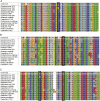Comparative genomics reveals the molecular determinants of rapid growth of the cyanobacterium Synechococcus elongatus UTEX 2973
- PMID: 30409802
- PMCID: PMC6294925
- DOI: 10.1073/pnas.1814912115
Comparative genomics reveals the molecular determinants of rapid growth of the cyanobacterium Synechococcus elongatus UTEX 2973
Abstract
Cyanobacteria are emerging as attractive organisms for sustainable bioproduction. We previously described Synechococcus elongatus UTEX 2973 as the fastest growing cyanobacterium known. Synechococcus 2973 exhibits high light tolerance and an increased photosynthetic rate and produces biomass at three times the rate of its close relative, the model strain Synechococcus elongatus 7942. The two strains differ at 55 genetic loci, and some of these loci must contain the genetic determinants of rapid photoautotrophic growth and improved photosynthetic rate. Using CRISPR/Cpf1, we performed a comprehensive mutational analysis of Synechococcus 2973 and identified three specific genes, atpA, ppnK, and rpaA, with SNPs that confer rapid growth. The fast-growth-associated allele of each gene was then used to replace the wild-type alleles in Synechococcus 7942. Upon incorporation, each allele successively increased the growth rate of Synechococcus 7942; remarkably, inclusion of all three alleles drastically reduced the doubling time from 6.8 to 2.3 hours. Further analysis revealed that our engineering effort doubled the photosynthetic productivity of Synechococcus 7942. We also determined that the fast-growth-associated allele of atpA yielded an ATP synthase with higher specific activity, while that of ppnK encoded a NAD+ kinase with significantly improved kinetics. The rpaA SNPs cause broad changes in the transcriptional profile, as this gene is the master output regulator of the circadian clock. This pioneering study has revealed the molecular basis for rapid growth, demonstrating that limited genetic changes can dramatically improve the growth rate of a microbe by as much as threefold.
Keywords: Synechococcus; cyanobacteria; growth; photosynthesis.
Conflict of interest statement
The authors declare no conflict of interest.
Figures




Comment in
-
Navigating the fitness landscape using multiallele genome editing.Proc Natl Acad Sci U S A. 2018 Dec 11;115(50):12547-12549. doi: 10.1073/pnas.1818285115. Epub 2018 Nov 21. Proc Natl Acad Sci U S A. 2018. PMID: 30463944 Free PMC article. No abstract available.
-
Reply to Zhou and Li: Plasticity of the genomic haplotype of Synechococcus elongatus leads to rapid strain adaptation under laboratory conditions.Proc Natl Acad Sci U S A. 2019 Mar 5;116(10):3946-3947. doi: 10.1073/pnas.1900792116. Epub 2019 Feb 12. Proc Natl Acad Sci U S A. 2019. PMID: 30755539 Free PMC article. No abstract available.
-
SNPs deciding the rapid growth of cyanobacteria are alterable.Proc Natl Acad Sci U S A. 2019 Mar 5;116(10):3945. doi: 10.1073/pnas.1900210116. Epub 2019 Feb 12. Proc Natl Acad Sci U S A. 2019. PMID: 30755540 Free PMC article. No abstract available.
Similar articles
-
A Specific Single Nucleotide Polymorphism in the ATP Synthase Gene Significantly Improves Environmental Stress Tolerance of Synechococcus elongatus PCC 7942.Appl Environ Microbiol. 2018 Aug 31;84(18):e01222-18. doi: 10.1128/AEM.01222-18. Print 2018 Sep 15. Appl Environ Microbiol. 2018. PMID: 30006407 Free PMC article.
-
Engineering Natural Competence into the Fast-Growing Cyanobacterium Synechococcus elongatus Strain UTEX 2973.Appl Environ Microbiol. 2022 Jan 11;88(1):e0188221. doi: 10.1128/AEM.01882-21. Epub 2021 Oct 27. Appl Environ Microbiol. 2022. PMID: 34705549 Free PMC article.
-
Adjustments to Photosystem Stoichiometry and Electron Transfer Proteins Are Key to the Remarkably Fast Growth of the Cyanobacterium Synechococcus elongatus UTEX 2973.mBio. 2018 Feb 6;9(1):e02327-17. doi: 10.1128/mBio.02327-17. mBio. 2018. PMID: 29437923 Free PMC article.
-
A circadian timing mechanism in the cyanobacteria.Adv Microb Physiol. 2007;52:229-96. doi: 10.1016/S0065-2911(06)52004-1. Adv Microb Physiol. 2007. PMID: 17027373 Review.
-
From cyanobacteria to plants: conservation of PII functions during plastid evolution.Planta. 2013 Feb;237(2):451-62. doi: 10.1007/s00425-012-1801-0. Epub 2012 Nov 29. Planta. 2013. PMID: 23192387 Review.
Cited by
-
Navigating the fitness landscape using multiallele genome editing.Proc Natl Acad Sci U S A. 2018 Dec 11;115(50):12547-12549. doi: 10.1073/pnas.1818285115. Epub 2018 Nov 21. Proc Natl Acad Sci U S A. 2018. PMID: 30463944 Free PMC article. No abstract available.
-
Enhancing photosynthesis under salt stress via directed evolution in cyanobacteria.Plant Physiol. 2025 May 30;198(2):kiaf209. doi: 10.1093/plphys/kiaf209. Plant Physiol. 2025. PMID: 40397698 Free PMC article.
-
A force awakens: exploiting solar energy beyond photosynthesis.J Exp Bot. 2019 Mar 27;70(6):1703-1710. doi: 10.1093/jxb/erz054. J Exp Bot. 2019. PMID: 30773590 Free PMC article. Review.
-
A Novel Cyanobacterium Synechococcus elongatus PCC 11802 has Distinct Genomic and Metabolomic Characteristics Compared to its Neighbor PCC 11801.Sci Rep. 2020 Jan 13;10(1):191. doi: 10.1038/s41598-019-57051-0. Sci Rep. 2020. PMID: 31932622 Free PMC article.
-
Impact of irradiance and inorganic carbon availability on heterologous sucrose production in Synechococcus elongatus PCC 7942.Front Plant Sci. 2024 Apr 8;15:1378573. doi: 10.3389/fpls.2024.1378573. eCollection 2024. Front Plant Sci. 2024. PMID: 38650707 Free PMC article.
References
Publication types
MeSH terms
Substances
LinkOut - more resources
Full Text Sources

